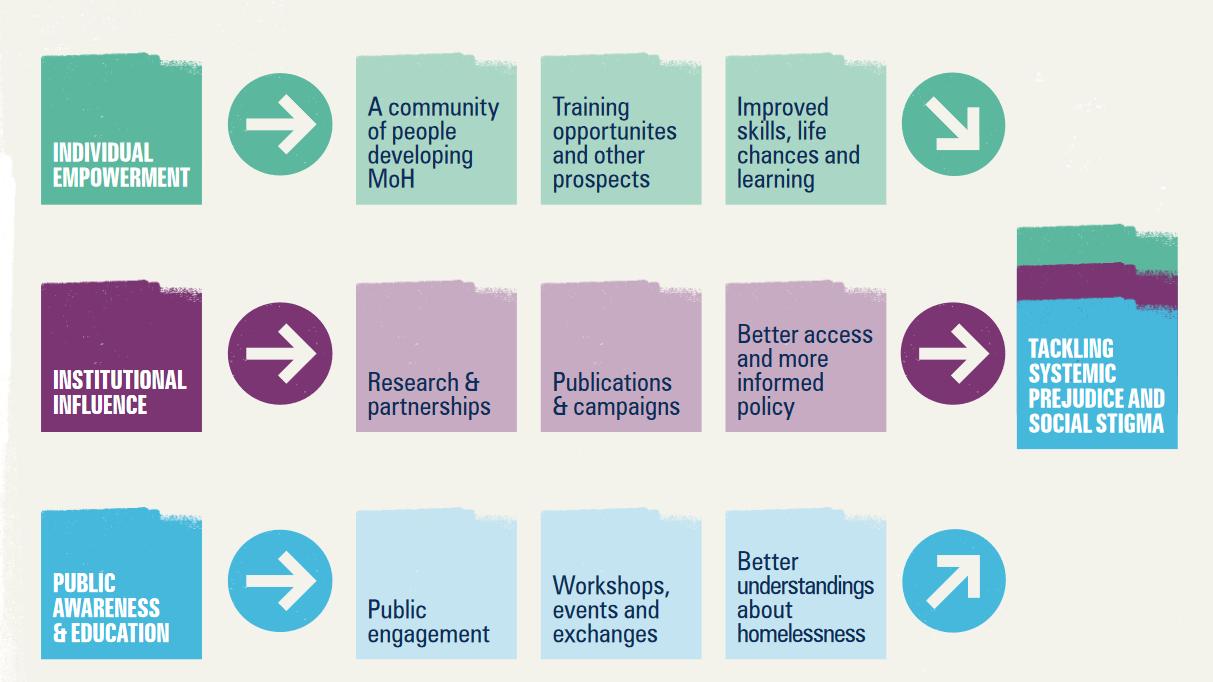Getting started
With core budgets tightening museums are increasingly dependent on shorter-term project work to help them achieve social value and undertake socially engaged practice. It is therefore important to be mindful that project work should fit into the organisational strategy and therefore contribute towards long-term goals.
Many organisations will have a Theory of Change in place to define their commitment to providing social value. These are the long-term aims of an organisation and project work should be designed to work towards achieving these.

Setting outcomes and outputs
The desired social impact may be defined at an organisational level in the mission, values and vision of a particular museum or in its Theory of Change.
For example, Tyne and Wear Archives and Museums set out their mission as: ‘to help people determine their place in the world and define their identities, so enhancing their self-respect and their respect for others’.
Projects should be aligned to the mission, values and vision of the organisation.
This can be achieved by setting outcomes and outputs that will contribute towards overarching organisational aims. Outcomes are the backbone of your work. They define the positive changes or improvements your project is designed to work towards. These outcomes set what it is you will be measuring when looking at the social value of your work.
Sometimes outcomes are bigger than one project and your activities will only partially contribute to it. This is fine, and longer-term thinking can add to a projects value and indeed the strength of the organisation overall.
The outputs are the activities you will undertake to achieve your outcomes and can be used to set your evaluation framework.
Ethical considerations
It is important to think about your participants when choosing your outcomes as there are ethical issues to consider when selecting them.
Are your outcomes appropriate and useful for all participants? The Museum of Homelessness takes its ethical responsibilities very seriously and says they would be unlikely to set outputs relating solely to employability, for example, unless they were specified by participants themselves.
“Our team, informed by lived experience of homelessness, has set outcomes such as an increased sense of social connection or a sense of common purpose. We don’t believe that employability is the only way an individual can be of value to society and reflecting that in our outcomes sends an important message” says Jess Turtle, co-founder of the Museum of Homelessness.
By working with participants to set outcomes at the start of a project you can avoid these pitfalls and make the work a two-way process.
Logic models
Once you are clear about your desired outcomes you can begin putting processes into place for the measurement of social impact. Outcome-based evaluation is an approach for demonstrating social value and works on the basis of an outcomes-based commissioning framework.
There are lots of different formats to display simply whether your activities will result in your desired outputs and outcomes but creating a logic model can be a useful starting point. This will define when and what to evaluate. A logic model is intended to be brief, summarising the project at the top level of its activities and purpose.
The logic model should help people involved in the project to:
- get an overview of its outputs and objectives
- test whether the resources and activities are enough to achieve the outputs and contribute to outcomes
- set the aims and objectives in context: short-term outputs should be evident during the lifetime of the project, medium-term outcomes should begin to be measurable in evaluation, and longer-term outcomes are less attributable to the individual project and perhaps not measurable in the lifetime of the project but are nevertheless key drivers
- identify assumptions that must be true for the project to work, i.e. areas that people working on the project should keep an eye on
- monitor changes to the overall project by periodically updating the logic model.